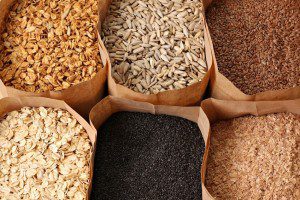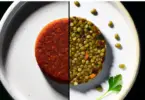Contributing writer for Wake Up World
Grains became one of the hot topics today in the nutritional and natural health world. People don’t understand how come a food that their whole family used to eat for so long became “bad” all of a sudden. Reality is that problems like gluten sensitivities, obesity and celiac disease are on the rise and directly related to grain consumption, especially processed grain. Sensitivities became so severe in some people that they can’t even tolerate soaps containing gluten on their bodies.
All kind of high protein, no-grain diets advise against grain consumption based on various health theories, one being that grains are a pretty new food and our digestive system didn’t evolve in order to process it, hence all the health problems.
High carb diets believers on the other hand argue that a low carb diet can be really hard on your hormones, especially on your thyroid, so it’s to be avoided. But then, according to the USDA, grains should constitute a sizeable sector of our diet in the form of “bread, cereal, rice, and pasta.” And this has actually no nutritional theories behind it in my opinion, but just the opportunity to make profits for a big processed food industry.
[pro_ad_display_adzone id=”110028″]
Grains are full of toxic lectins, phytates and oxalates, alpha-amalyase and trypsin inhibitors, and endocrine disrupters. Some say if you sprout them you can still consume them, some say it doesn’t matter the form, they can still damage your digestive system and your health.
Are you confused and tired yet? I bet you are! So, where does the truth lie?
The truth lies within anthropology and genetics. Let’s see how:
Grain Around The World
To understand what humans need nutritionally you must understand the environment in which our development occurred. If I think about my own heritage, then I can say that my Romanian ancestors used to consume considerable amounts of millet and wheat for thousands of years, yet having a high longevity and enjoying a robust health, like most ancient cultures.
The human body was developed through our physical and cultural responses to our environment. By looking at well-established scientific laws and theories of the science of anthropology, the only conclusion to the question of human nutrition is that there is far too much genetic diversity in the human species to logically argue for any type of one-size-fits all nutrition plan that will make every person that follows it healthy.(1)
In the book ”Nutritional and Physical Degeneration” by Weston A. Price, DDS. Dr. Price details his studies of 14 indigenous cultures throughout the world.
What he found throughout the globe were extremely healthy populations, with no incidence of degenerative disease. These peoples ate foods natural to the environment in which they were born and the types of food sources varied considerably among cultures. But Price also found that as soon as people adopted modern foods they started to show signs of deficient development and tooth caries would increase rampantly in the exposed native populations.
Over thirty years of research and clinical study in metabolic individuality helped us understand today that if our genes are like the indigenous Swiss, then grains are not bad for us and we can thrive on them. But if we have genes like the Eskimo, then red meat and high saturated fat will not contribute to cancer and heart disease but will help prevent it or even reverse it if we develop it. Taken further, we’ll feel terrible on a high carb diet even if it is organic, whole, natural food and we may even develop cancer, diabetes, arthritis by eating that kind of diet. But the reverse is also true. If we have genes like the high carb eating Quechuas – 80% primarily from potatoes, wheat, corn, quinoa, barley, then omitting grains and eating like the Eskimo will be devastating.
As you see, one “grain” doesn’t fit all! The world is constantly changing and organisms must compete for limited resources in order to survive. They tend to change slowly from generation to generation and individuals of a species who are better able to find resources and mate more successfully are more likely to pass on their genes to future generations.
All indigenous cultures thrived on whole, natural foods. But the whole foods that were naturally available to the different cultures were different because they were determined by geographical location and climate. And, it’s these differences that gave rise to differences in genetically-based requirements for foods, biochemical/metabolic individuality, or what we have classified and refer to as Metabolic Types ®.
“Good” or “Bad” Food? There Is No Such A Thing!
“Through the perspective of Metabolic Typing, we know that when it comes to whole, natural, organic foods, there are no “good” foods and there are no “bad” foods – except in terms of the metabolic individuality of each person.”
Metabolic Typing® is essentially the clinical application of what Weston Price found in his travels to indigenous cultures. What Metabolic Typing ® reveals is that the concepts of good and bad and right and wrong are relative and must be defined according to each individual’s metabolic individuality. Everyone needs proteins, fats and carbohydrates, BUT the kinds of proteins, fats and carbs that you’ll thrive on AND the macronutrient ratios that you’ll thrive on (at each meal and snack) are based in your genes and are expressed clinically as your Functional Metabolic Type ®.
In order to achieve satiety, in order to eliminate sweet cravings, in order to resolve health issues, some Metabolic Types ® need some grains in their diets.“ William Wolcott, Founder of the Healthexcel System of Metabolic Typing
There are many scientists and health practitioners that claim grains are just “bad”. But these kind of findings are based on research that is no different than the research stating meat causes cancer, or saturated fat causes heart disease. It may apply in the lab, on a specific segment of population, but it does definitely not apply to clinical reality, it does not apply to everyone!
[pro_ad_display_adzone id=”110028″]
One Man’s Grain IS Another Man’s Poison
In an era where we literary live in a “genetic melting pot”, where different cultures coalesce, the concept of metabolic individuality or variation becomes more important than ever.
Dr. Roger Williams who studied biochemical individuality extensively, showed that people, while very similar in the overall view of genetics, are actually very different on the individual level. He studied the difference between people’s internal anatomy, their enzymatic patterns, their endocrine variations, and blood vitamin/mineral variations. He found considerable variation from person to person often with a hundred fold or more difference for the various compounds he was testing for.(1)
Taking now grains as an example, in metabolisms where the autonomic nervous system is dominant, grains have a mild effect. They do not really stimulate or inhibit strongly either the sympathetic or parasympathetic system, unlike vegetables, for example, which due to their high potassium and carb content, stimulate the parasympathetic system.
In metabolisms where the oxidative system is dominant, being a starchy carb, grains will tend to increase the oxidation rate. Which will usually translate into feeling hungry soon after eating a bowl of oats, and experiencing sweet cravings. And depending on how they are prepared, their phytate content could lower calcium and increase the oxidation rate from that perspective, as well, affecting certain metabolisms more than others.
These are general guidelines since we are all so different on a biochemical level. A food / diet that might make a person feel well, might have no effect in a different person and may make a third person feel worse.
The Problems With Grains Today: Processed and Altered
Do you think the type of wheat people consume today is the same with the type consumed hundreds of years and even thousands of years ago? Absolutely not. The sad reality is that people have become accustomed to the mass-produced, gooey, devitalized, and nutritionally deficient breads and baked goods that are sold today in stores and they have little recollection of how real bread should taste. Chemical preservatives allow bread to be shipped long distances and to remain on the shelf for many days without spoiling and without refrigeration.
Botonists have identified almost 30,000 varieties of wheat. But with the advent of modern farming, the number of varieties of wheat in common use has been drastically reduced. Today, just a few varieties account for 90 percent of the wheat grown in the world.
“When grown in well-nourished, fertile soil, whole wheat is rich in vitamin E and B complex, many minerals, including calcium and iron, as well as omega-3 fatty acids. Proper growing and milling methods are necessary to preserve these nutrients and prevent rancidity. Unfortunately, due to the indiscretions inflicted by contemporary farming and processing on modern wheat, many people have become intolerant or even allergic to this nourishing grain. These indiscretions include depletion of the soil through the use of chemical fertilizers, pesticides and other chemicals, high-heat milling, refining and improper preparation, such as extrusion.” (2)
The pesticides used function as xenoestrogens, foreign estrogen that disrupt hormonal balance and may be a contributing factor to a number of health conditions. Cycocel is a synthetic hormone that is commonly applied to wheat. Add to all this irradiation to control insects and genetical manipulation to achieve “desirable” changes, such as regulated germination and an increased ability to survive in cold weather. Heat damage is also a serious problem that results in denaturation of the protein in grains.
“Flour was originally produced by grinding grains between large stones. The final product, 100 percent stone-ground whole-wheat flour, contained everything that was in the grain, including the germ, fiber, starch and a wide variety of vitamins and minerals. Since grinding stones are not fast enough for mass-production, the industry uses high-speed, steel roller mills that eject the germ and the bran. High-speed mills reach 400 degrees Fahrenheit, and this heat destroys vital nutrients and creates rancidity in the bran and the germ. Dozens of dough conditioners and preservatives go into modern bread, as well as toxic ingredients like partially hydrogenated vegetable oils and soy flour.” (2)
It’s not hard to see why and how people could consume grains throughout history without experiencing negative effects, but they became so problematic in our modern times.
Safe and Healthy Ways To Consume Grains
Considering our modern clinical reality, I have now a set of general rules that I recommend to be followed, in order to minimize negative effects of grain consumption:
1. Learn about and experiment with ancient grains like: quinoa, amaranth, spelt, kamut, teff, buckwheat, millet. These haven’t undergone the “insult” that other grains like wheat have, as far as processing and manipulation. Choose organic and sprouted varieties.
2. If you suspect you have negative reactions to gluten, and you can’t test to know for sure, it’s better to avoid it completely. Most of the times you will do a benefit to your body.
3. If you want to still use wheat, ideally, you should buy organic whole wheat berries and grind them fresh to make homemade breads and other baked goods. The second best option is to buy organic 100 percent stone-ground whole-wheat flour at a natural food store.
4. If you do not make your own bread, there are ready made alternatives available. Look for organic sourdough or sprouted breads freshly baked or in the freezer compartment of your market or health food store.
5. Sprouting, soaking and genuine sourdough leavening “pre-digests” grains, allowing the nutrients to be more easily assimilated and metabolized. This is an age-old approach practiced in most traditional cultures. Sprouting begins germination, which increases the enzymatic activity in foods and inactivates substances called enzyme inhibitors.
Soaking neutralizes phytic acid, a component of plant fiber found in the bran and hulls of grains, legumes, nuts, and seeds that reduces mineral absorption.
All of these benefits may explain why sprouted foods are less likely to produce allergic reactions in those who are sensitive.
Article Sources
- 1. Rold, Daniel. Anthropology’s Insight into Health and Human Nutrition
- 2. Allbritton, Jen. Wheaty Indiscretions: What Happens to Wheat, from Seed to Storage – Weston A Price Foundation
- 3. Larsen, Clark Spencer. Our Origins: Discovering Physical Anthropology. New York: W.W. Norton & Company, 2008.
- 4. Ji, Sayer. Going Against the Grain Towards Better Health
Recommended articles by Raluca Schachter:
- Vitamin D Supplementation: This is Why It Can Be Wrong
- Hypothyroidism or Hashimoto’s? What You Need to Know and Why It Matters
- Understanding Cannabis Oil
- 6 Steps to Solve Your Blood Sugar Problems Permanently
- Antibiotic Resistant Infections: The Dangers… and How You Can Avoid Them
- What Really Happens When You Take Antibiotics?
- Understanding Inflammation and How to Eliminate It Naturally
- Listen to Your Body. Correct Food Ratios. Reverse Disease.
- Cholesterol Myths Debunked
- Follow The Money In “Sick-Care”: What’s Behind The Drugs And Needles?
- What Happens In Your Body When You Suffer From Thyroid Disease?
About the author:
 Raluca Schachter is a dedicated Clinical Nutritionist / Natural Health Practitioner a.k.a “The Health Detective”. Raluca was able to naturally reverse chronic health conditions she was struggling with most of her life, and now uses her knowledge to help as many people as possible do the same. Her health programs and diet plans offer a very unique and comprehensive approach to health, where individual nutritional and biochemical requirements are firstly met using specific nutrients and foods that each metabolism thrives on. Raluca offers her services to international clientele and her practice is fully online based. You can connect with Raluca at www.metabolicenergy.net and https://www.facebook.com/raluca.schachter.metabolicenergy
Raluca Schachter is a dedicated Clinical Nutritionist / Natural Health Practitioner a.k.a “The Health Detective”. Raluca was able to naturally reverse chronic health conditions she was struggling with most of her life, and now uses her knowledge to help as many people as possible do the same. Her health programs and diet plans offer a very unique and comprehensive approach to health, where individual nutritional and biochemical requirements are firstly met using specific nutrients and foods that each metabolism thrives on. Raluca offers her services to international clientele and her practice is fully online based. You can connect with Raluca at www.metabolicenergy.net and https://www.facebook.com/raluca.schachter.metabolicenergy
[pro_ad_display_adzone id=”110027″]







